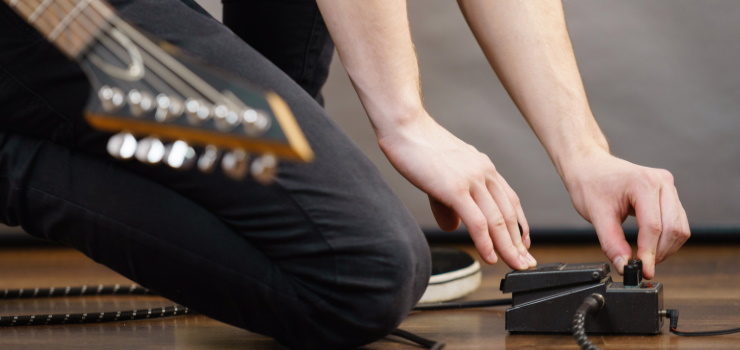To set up your guitar pedal, you need to:
Guitar pedals are useful devices that modify the e-signals created by an electric guitar, altering its melody or tone. These guitar pedals are used to make numerous effects, sounds, and echoes, from a hefty distortion to a powerful reverb.
With various types of guitar pedals available in the marketplace, it may feel overwhelming when you decide to buy yourself a guitar pedal.
Contents

You need to keep these three imperative points in mind associated with guitar pedals:
In this guide, we’ll describe the knowledge you should have under your belt to get started with your guitar pedal.
By any measure, these eight steps will help new and professional guitar players to set up their pedal:
Whenever you are attaching or detaching a pedal, you should cut the power supply to each and everything in the series/chain.
While both pedal and the amp should be flipped off while you connect the pedal, there is an exception to this rule: i.e. if you’re using a valve or tube amp. In this situation, you should keep the amp switched on and set the amp in the “standby” mode.
If you try and connect live circuits, it can result in short circuits and feedback bursts, or loud pops, which would come through the amp. Plus, it'll lessen the life of all the gears in your rig.
To ensure the pedal and the amp both are turned off before you connect these, you should have these plugged in. Connect both to power and turn these off and on to ensure.
Some guitar pedals come with 9V A/C adapters, on the other hand, there are some that are operated by battery. Usually, the guitars feature both choices. For various guitar players, battery-operated ones are great because it’s one less thing to plug in. However, they could be an annoyance as the batteries die and these can cost you a fortune.
Several pedals embrace only two jacks, both labeled "Input," and "Output." These jacks are commonly found on the contradictory sides of the pedal's body, reliant on the unit, and these are built to take a standard six mm (quarter-inch) audio cable. You need to find both the input and output jacks on the pedal, and then attach your guitar to the jack labeled as "input."
A ll of these outputs and inputs are puzzling for the novice. Keep in mind that the audio signal is produced by your guitar's pickups, and from there it travels towards the amp through the cable. Thus, the guitar must be attached to the input jack of the guitar pedal, as this tells the signal where to go. Now when you play a tone on the guitar, it will travel “in” to the guitar pedal and comes "out" and again goes back “in” to the amplifier.
Run another length of 6 mm cable from your guitar pedal to your amp. The cable linking the pedal to the amplifier must go into the same input directly where you would usually plug your guitar into.
To link a pedal, you need at least, 2 quarter-inch cables. If you are connecting more pedals, you likely require more patch cables to fit all things together without much trouble, however, if you are just plugging in, then 1 or 2 regular cables would work fine.
After you have got all of your cables plugged in, turn your amp on and put everything the way you like. Generally, it's superlative to keep your amplifier reasonably unaffected when you are trying out a guitar pedal for the very first time and to get a feel for how it sounds, nonetheless, feel free to try out. If you play with the amplifier always on the same settings, set it how you would like it.
If you are plugging in some type of space-echo or fuzzy distortion guitar pedal, you need to ensure you aren’t going to hurt your eardrums when you are going to put your foot on your pedal for the very first time. Set all the settings or frequencies low before activating the guitar pedal. You can alter these as you play.
To activate various pedals, you need to step on a lever or a button under the control knobs on the pedal. Usually, a green or red light will turn on, indicating that your pedal is activated. Explore the features of your pedal gently, turn on and off diverse effect knobs up when you are playing and get a feel of the tune. Play around with different effect orientations and volumes.
To switch various pedals off, you will step on the lever or button again, cutting the signal of the pedal and sending it through the amplifier. Play around with activation and deactivation of the pedal to get the type of tune you would like.
If you leave the pedal attached, the power would be drained, especially when you are using the batteries to turn on your pedal. Whenever you have cables attached to the output and input jacks, the power is drained from the pedal. If you aren’t playing actively, ensure that your pedal is detached and turned off. This way, it will last longer.
Copyright © 2024 MSpot. All rights reserved. Privacy Policy & Cookie Disclaimer.
mspot.com is a participant in the Amazon Services LLC Associates Program, an affiliate advertising program designed to provide a means for sites to earn advertising fees by advertising and linking to Amazon.com. As an Amazon Associate, we earn from qualifying purchases.